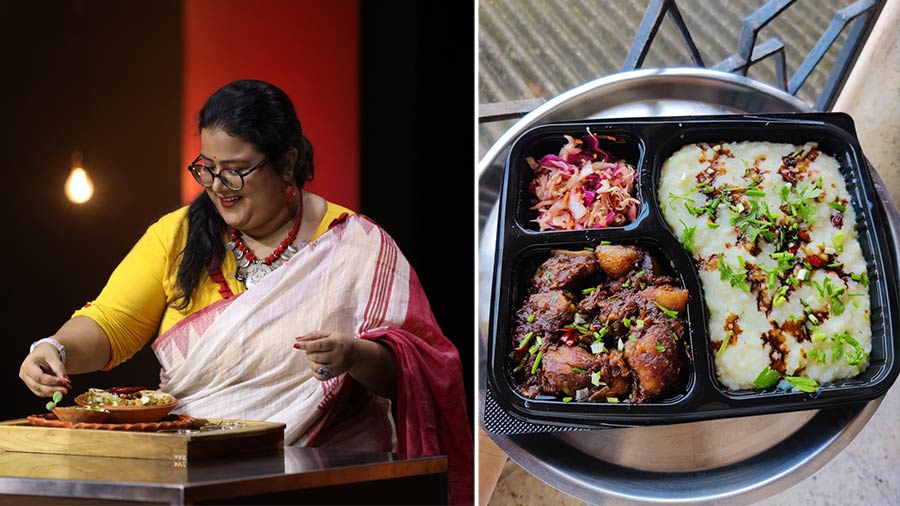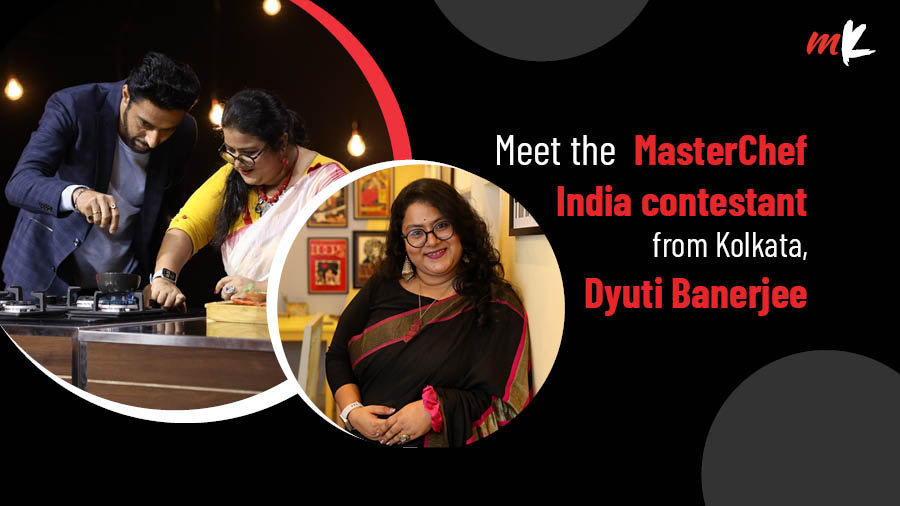Monsoon, for me, has always meant the last of the mangoes, and the first of the Ilish. Or at least, that’s what my childhood monsoons were like. A street made unrecognisable by rainwater (and drain water), squelching black Bata ballerinas, white socks sieving the muck out, and a school skirt hoisted high. That joy of waddling through this endless bathtub, and sometimes pool, came at the cost of scrubby hot baths immediately after. The relief after it all would only come in the wet evenings—ada cha, followed by shingaras or Bijoli Grill fish fry or mutton cutlet, always with a generous side of brain-burning kasundi. As I grew older, I formed a fond, guiltless kinship with telebhajas—the jhaal alur chop, the muchmuche beguni, the slightly sweet mochar chop, and of course, Mughlai porota. Gradually, momos and dry chilli pork entered my palate, and my bikeler jolkhabar had an insane variety to choose from.
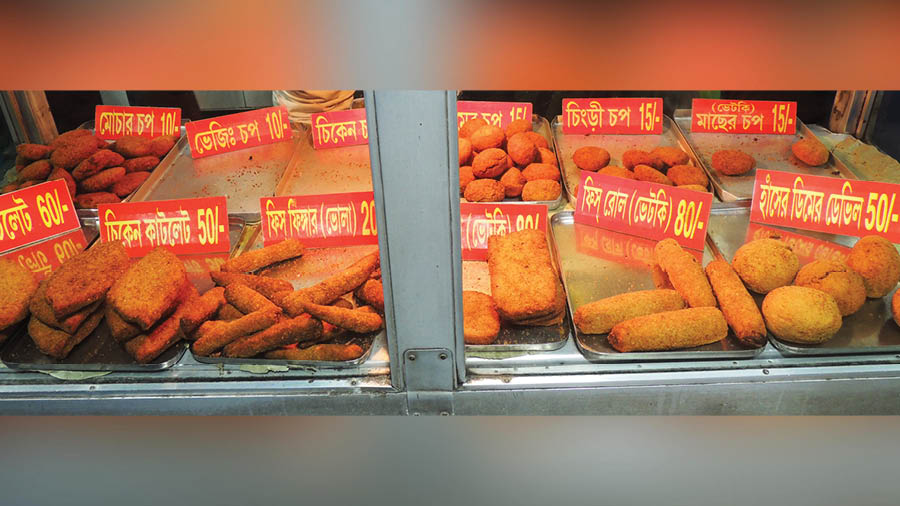
‘I formed a fond, guiltless kinship with ‘telebhajas’,’ says Dyuti TT Archives
My favourite borsha dinner has always been bhaja moong daler khichuri with Ilish machh bhaja, begun bhaja, mushur daaler bora or at the very least an omelette bursting with kanchalonka and onions, fried generously in mustard oil. This was what I ate mostly out of my grandfather — my Baboojidada’s — plate, not bothering about my own, because food was always tastier on his plate. Another favourite, of course, was soft mushy Gobindobhog rice with some dried baashi dal and an alu sheddho turned red with red chillies fried crisp in pungent mustard oil. Monsoon meals have always meant petrichor and burning nostrils and my grandfather’s scary bhooter golpo, which he claimed were all true stories.
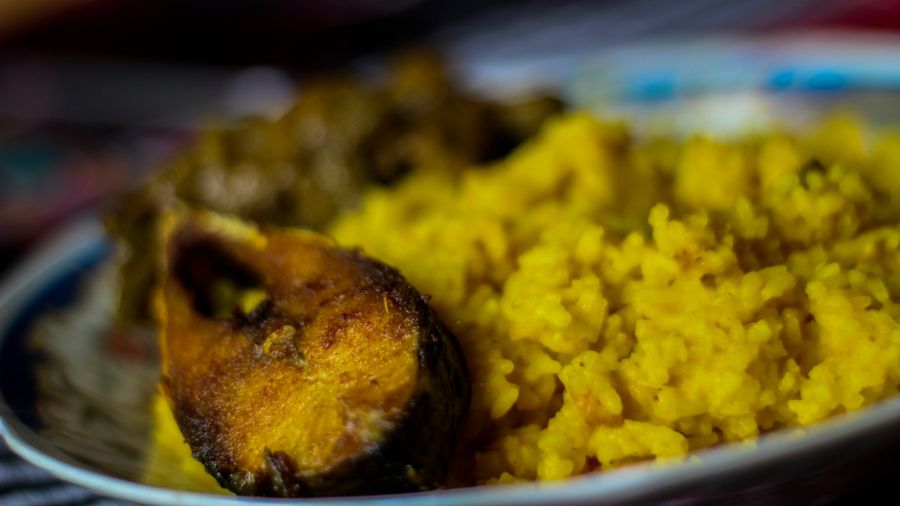
‘Bhaja moong daler khichuri’ with ‘Ilish bhaja’ was another monsoon staple from Dyuti’s childhood TT Archives
It was only natural that when I began my cloud kitchen, The Calcutta Calorie, I had to have something on my menu that would be as fiery, yet as comforting as those meals from my childhood and even early adulthood. Memories of khichuri and phena bhaat (or, fyana bhaat) came rushing in, and I remembered that Japanese breakfast I had upon waking up at Eros Hotel in Nehru Place in Delhi. After a particularly intense monsoon weekend in 2014 spent at JNU, that breakfast warmed the numb cockles of my 20-something-old heart. There was a congee, simple and something you could add to easily, with a bit of miso here, a few scallions there, some exciting cured salmon, some fresh crab meat, a few just-done pink shrimps. That breakfast remains the best breakfast of my life, and one that made me own with pride my love for our own Bengali congee, our phena bhaat.
Cut to 2021 and a few seas of change later, the congee I came up with had Gobindobhog rice boiled to a gruel. If you find gruels too gruelling, then you may skip this part, but because I love gruels, I’m going to finish this one nevertheless.
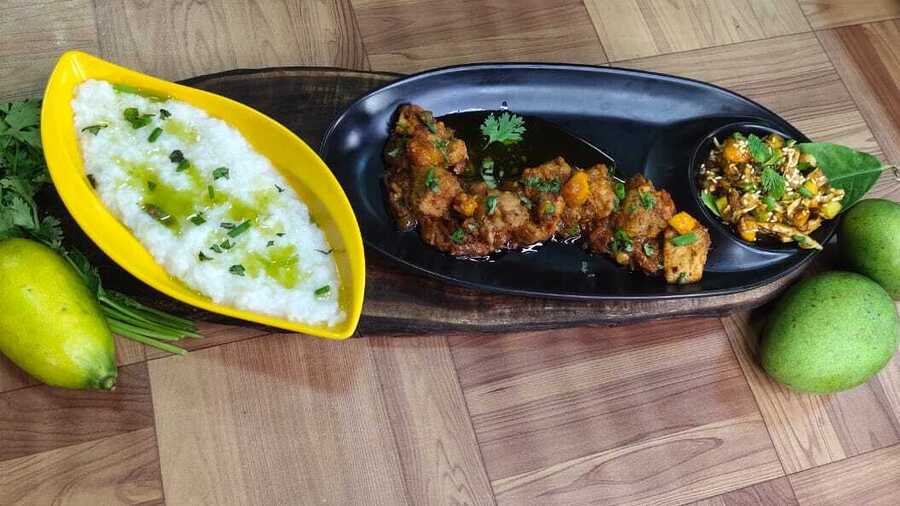
The congee and Mango Chilli Pork made by Dyuti Courtesy Dyuti Banerjee
Bengali congee or phena bhaat
Ingredients
- Gobindobhog rice: 1 cup
- Lemongrass: 1 whole
- Ginger julienne: 1 tbsp
- Ripe chillies: 1-2 or more
- Gondhoraj leaf: 1 pc
- Gondhoraj lime: ½ tbsp
- Salt
Method
- There is no water to rice ratio for this, you can make it as slurpy or as ‘tight’ as you please
- While the water is boiling, drop a whole lemongrass tied up in knots along the length in the pot
- Plonk the washed rice in, and let it boil till the rice has released all its starch and the water is cloudy (visually befitting monsoons too, isn’t it?)
- While the rice is cooking, julienne some ginger, a few ripe chillies, drop them in, and add salt
- When the broth reaches the consistency that your heart desires, add a Gondhoraj leaf in, turn off the heat, and squeeze in just a dash of Gondhoraj lime to add a bit of freshness to break through the carb-rich warmth
Now if you find this too bland (or not), you need to balance it out with something robust, like they used to say back in Delhi, faadu spicy meat dish, and what better meat than pork? You should not, but if you must, you can substitute pork with chicken. This is my Mango Chilli Pork recipe, and it’s made with ripe Langra mango, so trigger warning alert for puritans, but I will share this slightly demented recipe for those willing to push the boundaries of food and flavour stereotypes, and unravel a world of limitless possibilities.
Mango Chilli Pork
Ingredients
- Lean pork: 200-250 gm
- Pork fat: 250-300 gm
- Onion: one cup
- Garlic: 2 tbsp
- Bhoot jolokia (or ghost pepper): 1 pc
- Dalle chillies (pickled): 1 pc
- Dried red chillies (shuknolonka): 1 pc
- Black pepper powder: 1 tsp
- Lyangra mango (ripe): 1 large
- Honey: 1 tsp
Method
- Begin with two cuts of pork, some lean, some with the glorious fat on. So if we’re cooking 500gms of meat, let there be 200-250 gms of lean pork and the rest with fat. The reason is, this recipe needs little or no oil, as it is cooked mostly in rendered pork fat. If you’re using chicken, the best cut would be boneless thighs. Because a bit of frying is involved, breast pieces can lose some tenderness. This recipe is my mangoe-y take on an Ahom tribal recipe made with juicy ripe pineapple and chubby pork. I twisted it with Lyangra aam to Bengalify it and to test the versatility of paaka aam.
- On medium heat, cook the pork in a pan. If you’re using chicken, use any neutral oil to fry it
- Once the fat begins to release, add salt and keep cooking, till enough fat is rendered
- Take the pork pieces off the heat
- If cooking with chicken, fry till slightly golden brown on the edges, and take off the heat immediately. Should not take more than 5-8 minutes
- To the sizzling pork fat or oil in the pan, add sliced onions and macerated minced garlic. Fry till golden and fragrant
- Now is the time for the real drama. Bring on your hottest chillies for the ultimate meaty bling. My favourite combination for this is a deadly punch of a pinch of crushed Bhoot jolokia, one or two pickled Dalle khursani and one sliced shuknolonka. If you don’t have the Bhoot jolokia and Dalle , go all out with the shuknolonka and a few paka lonkas (fresh red chillies). The flavour may not be the same, but it won’t be a compromised version, I assure you
- Additionally, add some freshly crushed black pepper according to taste
- Cook it all till the heat reaches your nostrils. Once your nose sputters, know it’s time to add the fried pork or chicken pieces back into the pan
- The pan will have turned pretty sticky by now, which means it’s time to deglaze the pan. Splash in a handful of water, and let it cook, covered. You will have to repeat this step till the meat is cooked to tenderness
- Meanwhile, add in the chopped pulp of a large ripe Lyangra (or any other mango you can get your hands on), and cook covered. Let it all reduce together
- Check for salt, you may add a teaspoon of honey if the heat is still too much for you. And that’s it, you’re done!
Tips
Dress up your congee with either a homemade mint oil, or chilli oil, or a piquant dressing made with soy sauce, lime juice, honey, with minced garlic, ginger, chillies and scallions. Serve with the fiery succulent Mango Chilli Pork or Chicken and some sweet and tart pickled cabbage, onions, kancha aam or anything you wish for, for that juicy crunch. Thank me later!
Enough ranting in the name of a recipe. I shall now nurse this monsoon’s only curse — a pesky viral fever — with a bowl of a peppery, garlicky chilli Maggi. I forgot to mention, Maggi tops the list of monsoon comfort foods for me, and if you’re sick or lazy, just forget any recipe ever existed and make yourself your favourite Maggi bowl and let the world fade away into the rain! Bon Appetit!
